Are you on the side of the road with a leaking brake line and unsure what to do? Don’t panic! While a leaking brake line can be a serious issue, there are steps you can take to fix it temporarily and get your vehicle back on the road.
This article will show you how to use a brake line repair kit to seal a leaking brake line and get your vehicle moving again quickly and easily.
So, if you find yourself stranded with a leaking brake line, don’t hesitate to follow our guide, and get your vehicle moving again in no time.
If a brake line is leaking, it is important to fix it as soon as possible to avoid losing brake fluid and potentially damaging the brake system.
The best way to temporarily fix a brake line is to use a brake line repair kit, which typically includes a piece of rubber hose and clamps. To use the kit, first, locate the leak in the brake line and clean the area around it with a wire brush.
Then, cut a piece of the rubber hose to fit over the leak and secure it in place with the clamps provided in the kit. This will provide a temporary seal and allow you to drive the vehicle to a mechanic for a more permanent repair.
It’s important to remember that this is only a temporary fix, and a professional should repair the brake line as soon as possible.
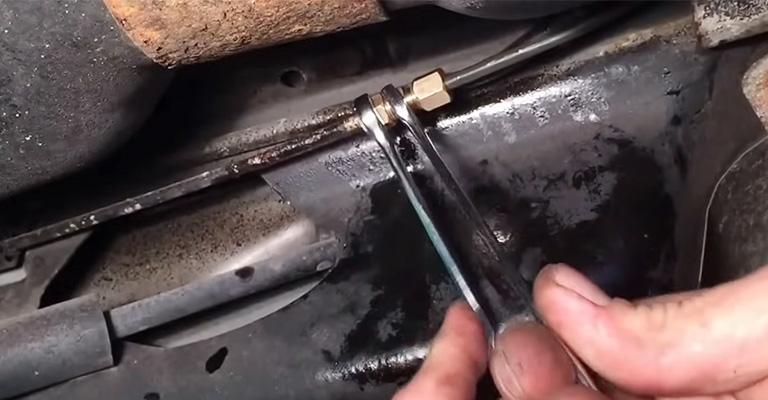
Contents
How Do You Fix A Hole In Your Brake Line?
It is extremely dangerous to have a leak in your brake line for you and anyone else on the road. The first thing to remember is that brake lines cannot be patched long.
In the case of a minor leak and enough fluid remaining to reach the mechanic, Rescue Tape is a short-term and temporary fix that gets you to a service station.
In other words, if you have a hole in your brake line, you can only fix it by removing the entire brake line and replacing it.
Custom-fitted metal pipes make up brake lines, which must be cut, bent, and flared correctly. Pre-made brake lines and flaring tools can be cut to fit your needs, but it is not a project for a beginner.
The steps involved in replacing brake lines are as follows:
- Identifying the old brake lines that need to be replaced and measuring them accurately
- Creating new lines by custom cutting, bending, and flaring
- Installing new lines after removing old ones
- Ensure that your brake fluid is properly refilled and that your brake lines are bled
You should not attempt these DIY projects if you are a beginner. If the car needs to be repaired, you may want to take it to a mechanic.
It typically costs $200 to $500 to fix a hole in a brake line, depending on what the mechanic charges for labor. A bit pricey, but safety is priceless.
Fixing A Brake Line Quickly | Alternative Method
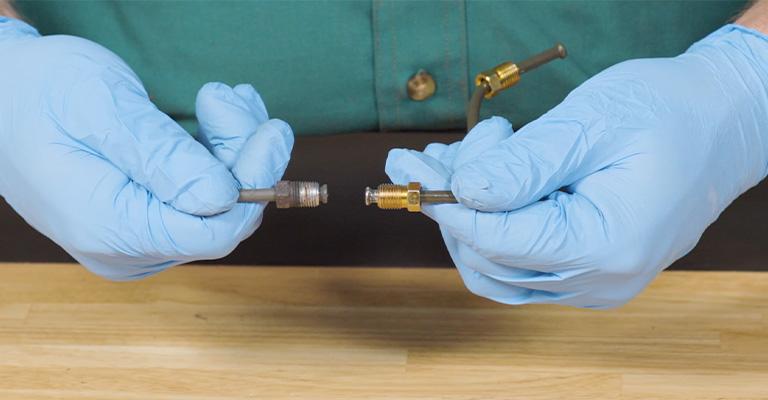
It is extremely dangerous to drive with leaky brake lines. We do not recommend this method as a quick way to fix a brake line.
If that’s the only stop you make and it’s not too far from the mechanic, it’s a temporary short-term fix that can get you to the mechanic. If you try this, please drive carefully and at your own risk!
To patch the brake line leak, you will need an adhesive, such as tape or rubber cement. It is possible to patch hydraulic and brake systems using a special glue available at most auto parts stores.
Do not allow any of these materials to enter the brake line, as they could cause serious damage to other components. There are a lot of DIY car enthusiasts who keep Rescue Tape in their glove box or trunk.
Use this to temporarily fix your brake line until you can get to the mechanic. The use of duct tape or electrical tape has been mixed by some drivers as well. Getting to the mechanic safely and quickly is the most important thing here.
The best way to drive your car is to think that your great-great-grandparents are cruising on the car’s hood with you. Avoid making unnecessary stops while driving, braking gently, and driving slowly.
Is It Safe To Drive With A Leaking Brake Line?
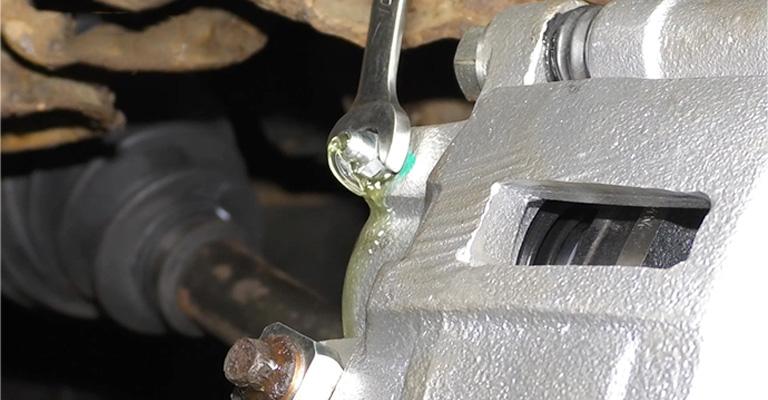
Make sure your mechanic inspects your car immediately if you notice any fluid leaking from your vehicle. By driving with a compromised brake system, you risk your safety and your passengers’ safety.
Can I Duct Tape My Brake Line?
No, you should not duct tape your brake line. Duct tape is not strong enough to withstand the pressure and heat generated by the brake system, and it could fail, causing a loss of braking ability and potentially leading to an accident.
Brake lines should be repaired or replaced by a qualified mechanic. If your brake line is leaking, it is important to have it fixed as soon as possible to ensure the safety of your vehicle.
I recommend a compression fitting union if you want a cheap and easy repair. Put the brake line back together with the union after cutting it with a tubing cutter.
You should always put ferrets on the correct way, usually the direction they come from when new. Make sure the fitting is not over tightened.
Using duct tape as a brake line repair is unreliable, and I wouldn’t leave my driveway with it. The tacky glue on the tape will be compromised very soon by the vehicle’s brake fluid. Most of the time, the tape will fail at the most inconvenient time.
Suddenly losing brake fluid and pressure, you won’t be able to slow or stop, posing a deadly hazard to yourself and other passengers.
The Best Way To Stop Safely If Your Brakes Fail
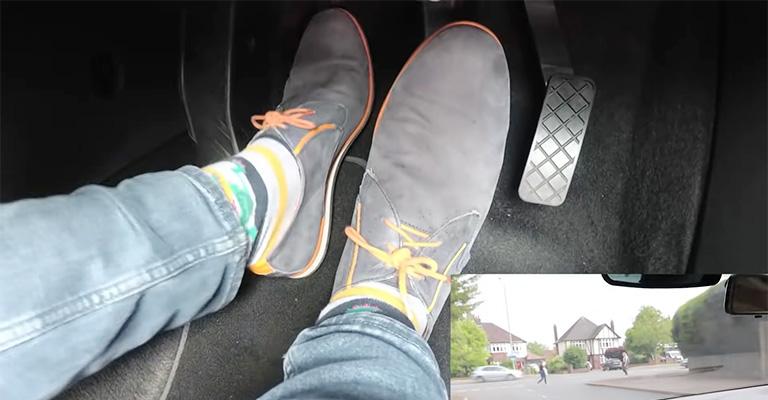
It is rare for brakes to fail when they are well maintained, but accidents can happen at any time. In an emergency brake situation, ensure you know how to stop safely.
The first thing you need to do is to pump the brake pedal three to four times. You may slow your speed by building up sufficient pressure in your brake line.
The brake lights will also flash when you pump the brakes, warning the driver behind you early that there is a problem. Turn on your hazard lights if pumping your brakes doesn’t work. Also, now would be a good time to downshift.
Next, slowly apply your parking brake. Make sure your parking brake is fully engaged. To avoid losing control, ease back on the brake pedal if you feel the tires skidding. Parking brakes are only half as powerful as pedal brakes, so stopping your car will take twice as long.
Lastly, bank your car in a soft, safe area. You must slow down below 20 mph before pulling off the road. You can stop your car more quickly if you drive on grass, weeds, and dirt than on pavement.
Breathe deeply now. It’s your due!
Whenever your brakes fail, do not cut the engine. Your car will become uncontrollable if you cut your engine, regardless of how tempting it may seem.
Can You Use Flex Seal On Brake Lines?
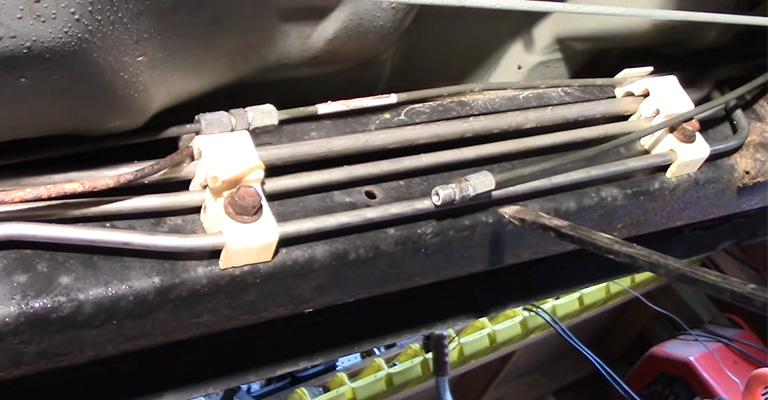
No, it is not recommended to use Flex Seal on brake lines. Flex Seal is a liquid rubber sealant commonly used for sealing leaks in roofs and gutters, but it is not designed for use on brake lines.
Brake lines are under high pressure and heat, and Flex Seal is not strong enough to withstand these conditions.
Additionally, Flex Seal may not provide a reliable seal on brake lines, which could cause a brake system failure and lead to an accident. Having your brake lines repaired or replaced by a qualified mechanic is best.
Final Words
From the master cylinder on the driver’s side firewall in the engine compartment along the underside of your vehicle, brake lines connect components along the way.
In addition to weather and road conditions, they are designed to withstand everyday wear and tear. Nevertheless, they are prone to rusting and pitting over time. Regular maintenance should include an inspection for damage and fluid leaks.
